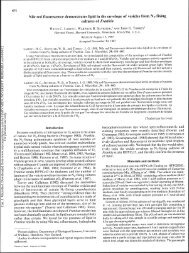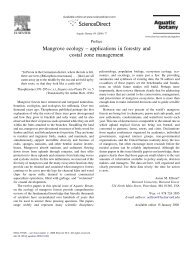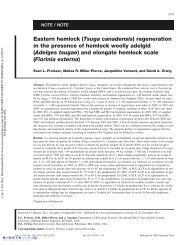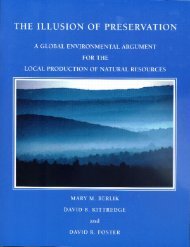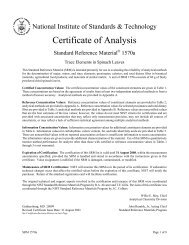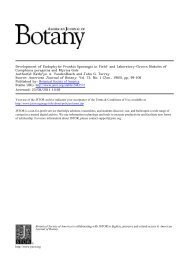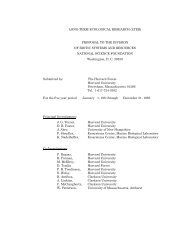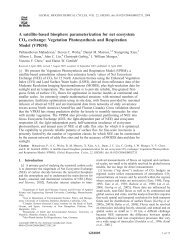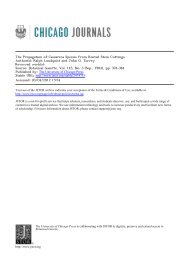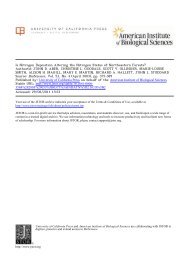Abstracts of Papers - Harvard Forest - Harvard University
Abstracts of Papers - Harvard Forest - Harvard University
Abstracts of Papers - Harvard Forest - Harvard University
Create successful ePaper yourself
Turn your PDF publications into a flip-book with our unique Google optimized e-Paper software.
Symposium: Assessing Air Quality with<br />
Lichens and Bryophytes-Part I<br />
BRYOLOGICAL AND LICHENOLOGICAL SECTION<br />
INTRODUCTION - Parts I and II<br />
This symposium will address various methods <strong>of</strong><br />
using lichens and bryophytes in air quality monitoring.<br />
<strong>Papers</strong> will include the topics <strong>of</strong> floristic<br />
analysis, mapping <strong>of</strong> sensitive species, statistical<br />
analysis <strong>of</strong> quantitative data, correlating<br />
fumigation studies with physiological effects and<br />
with field studies, trace element analysis, species<br />
variability with respect to air pollution and the<br />
ecological importance <strong>of</strong> lichens and bryophytes.<br />
These papers will summarize techniques presently<br />
in use and evaluate their reliability and usefulness<br />
in assessing air pollution damage.<br />
Organized by Clifford Wetmore, <strong>University</strong> <strong>of</strong> Minnesota,<br />
St. Paul, MN and James Bennett, National<br />
Park Service, Denver, CO.<br />
BENNETT, JAMES P. National Park Service, Air<br />
Quality Division, Box 25287, Denver, CO 80225.<br />
- The air pollution importance <strong>of</strong> non-vascular<br />
plants to the National Park Service.<br />
The National Park Service (NPS) has a mandate to<br />
protect the biological resources <strong>of</strong> the national<br />
parks from the effects <strong>of</strong> air pollution. Under<br />
Clean Air Act regulations, the NPS has authority<br />
to determine whether or not higher than ambient<br />
S02 concentrations will cause adverse impacts on<br />
lichens and mosses in the parks. The NPS consid-<br />
ers non-vascular plants as integral components<br />
<strong>of</strong> natural ecosystems because <strong>of</strong> their ecological<br />
importance as colonizers, nitrogen-fixers, food<br />
sources and soil stabilizers. Their position at<br />
the base <strong>of</strong> many food chains makes their role <strong>of</strong><br />
primary importance.<br />
Lichen sensitivity to S02 and heavy metals<br />
is well known. Several national parks are cur-<br />
rently experiencing elevated S02 concentrations,<br />
some high enough to cause effects on lichens and<br />
mosses. The NPS has initiated six projects on<br />
lichens and mosses and air pollution, including<br />
floristic studies, sulfur baseline sampling,<br />
heavy metal sampling, and ecological community<br />
analyses. These studies will enable NPS to de-<br />
termine future adverse impacts on non-vascular<br />
plants in the parks.<br />
NASH III, THOMAS H. Department <strong>of</strong> Botany<br />
& Microbiology, Arizona State <strong>University</strong>,<br />
Tempe, AZ 85287 - Correlating fumigation<br />
studies with field effects.<br />
Differential tolerance <strong>of</strong> different lichens<br />
to the environment <strong>of</strong> cities and isolated<br />
pollution sources is well established. It<br />
is frequently assumed that these patterns<br />
reflect differential sensitivity to sulfur<br />
dioxide and/or other air pollutants. This<br />
assumption may be false or only partially<br />
true because lichens may well respond to<br />
alteration <strong>of</strong> other environmental factors.<br />
Fumigation studies with controlled levels<br />
<strong>of</strong> air pollutants provides a means for ex-<br />
perimentally establishing whether lichens<br />
are in fact sensitive to air pollutants.<br />
It is important that both realistic exposure<br />
durations and realistic pollutant concentra-<br />
tion levels be employed. Furthermore, ex-<br />
posure conditions must be chosen to reflect<br />
conditions characteristic <strong>of</strong> the environment<br />
where th lichens occur naturally. The fumi-<br />
gation literature is critically examined<br />
with respect to these caveats and examples<br />
are given where the hypothesis that lichens<br />
are sensitive to air pollutants is both<br />
supported and not supported.<br />
NIEBOER, EVERT* and KEN A. KERSHAW, Departments <strong>of</strong><br />
Biochemistry and Biology, McMaster <strong>University</strong>,<br />
Hamilton, Ontario, Canada, L8N 3Z5.<br />
- Ecological Implications <strong>of</strong> Laboratory Toxicity<br />
and Related Photosynthetic Studies.<br />
It will be demonstrated that a large proportion <strong>of</strong><br />
the elemental content <strong>of</strong> lichens is the result <strong>of</strong><br />
particulate trapping within the interstitial spaces<br />
<strong>of</strong> the thallus. A strong dependence on surface<br />
morphology can be illustrated for this phenomenon.<br />
Such accumulation may be expected to be relatively<br />
innocuous. Recent studies will be reviewed that<br />
show that the largely passive extracellular uptake<br />
<strong>of</strong> metal ions can be either protective or deleteri-<br />
ous, depending on the chemical reactivity <strong>of</strong> the<br />
metal cation. Dissection studies are reported that<br />
indicate that metal-ion binding occurs to both the<br />
algal zone and fungal medulla, and that the uptake<br />
capacities <strong>of</strong> these zones, as well as the total<br />
uptake, are strongly lichen species dependent. Work<br />
with the uranyl ion further illustrates the import-<br />
ance <strong>of</strong> chemical speciation. And finally, toxic<br />
effects <strong>of</strong> ion absorption and SO2 exposure are shown<br />
to be ameliorated by the mineral status <strong>of</strong> the<br />
thallus (high Ca2+, Mg2+, K+ contents), by uptake<br />
inhibition (phosphate competing with arsenate; metal<br />
-ion rivalry), and high photosynthetic capacities.<br />
In this context, laboratory studies that simulate<br />
seasonal variations in photosynthetic capacities are<br />
summarized. In addition to species susceptibility,<br />
these observations imply a substrate and seasonal<br />
dependence <strong>of</strong> the toxicity to lichens <strong>of</strong> environmen-<br />
tal pollutants. Inferences for the use <strong>of</strong> lichens<br />
as monitors <strong>of</strong> environmental pollution will be<br />
pointed out.<br />
PUCKETT, KEITH.* J. & SEDIGHEH SANG.<br />
Atmospheric Environment Service,<br />
Environment Canada, 4905 Dufferin St.,<br />
Downsview, Ontario, M3H 5T4.<br />
-Trace element mapping with lichens and<br />
bryophytes.<br />
Since lichens and bryophytes are known to<br />
obtain and accumulate metal pollutants as<br />
well as their required nutrients from the<br />
atmosphere (either from rainfall or by<br />
impaction and sedimentation <strong>of</strong> airborne<br />
dust), they have been employed as<br />
biological indicators <strong>of</strong> trace element<br />
fallout in a great number <strong>of</strong> studies. In<br />
this paper enhanced levels <strong>of</strong> elements in<br />
lichens and mosses were reviewed and the<br />
usefulness <strong>of</strong> these plants for monitoring<br />
and mapping the concentrations <strong>of</strong><br />
1




